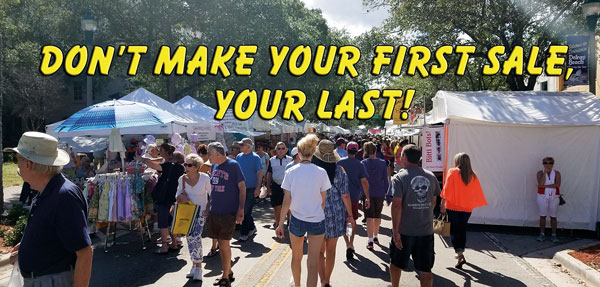Once you’ve made your presentation, sold the piece of work and taken the customer’s money, the sale is over, right? WRONG ! You are right in a way because the first part of the sale is over, but what could be the most profitable part of the relationship has just begun because every customer who buys from you once will probably buy again given the chance.
An old salesman once said that the best place to look for new sales is among those who have already purchased from you before. This does make a lot of sense too because you already know the customer likes your work, thinks it’s well worth the money and given the right opportunity they will buy. This doesn’t mean we don’t ever look for more customers, but it does mean we have a ready stable of proven buyers and it’s simply a matter of regular, effective communication with those people that will turn them into repeat clients.
The next question is, how do I communicate? The first step is to make sure you get the name, address, email address and phone number of the customer. These can be stored either in a program on your computer or even in many applications available right on the web using the internet. If you don’t have a computer, then just keep them in a cardfile… it’s low tech, but it works! How ever you store the names, get them and keep them. The communication can be as simple as a hand written note that you photocopy to an elaborate four color brochure developed by a design firm. Another way to contact customers on a regular basis is by email and internet web sites. Here I’ll offer a word of caution… it used to be that you could just blast off a bunch of email messages to whomever you wanted to. Those were the good old days! But today the internet service providers are a lot more picky about what gets sent. If you find that all of a sudden your email account has been blocked then you can bet that the ISP has got your number. Try not to send out too many emails at once… that means more than about 25 per minute in most cases. You can actually use Microsoft Word to send groups of emails and it has “throttling” features in it that allow you to slow down the sending of the message. Alternately if you’re even a bit more of the techie type you could even set up your own mail server. There are lots of free programs that allow you to do that! Facebook is another way to stay in touch with your customers. It’s simple and easy… you can share everything from pictures to movies to personal greeting or for that matter just about anything else you can put into a computer. The great thing is that most of these tech ideas are either free or close to it!
No matter how you contact your potential buyers, the important thing is to keep telling them where you’re going to be selling, new products you have and all the reasons the should be buying. Remember that the more reasons you give a customer to buy, the more they’ll purchase from you. Don’t assume they know you have special Christmas items, don’t take for granted they know you take special orders, make sure your customers realize you change the items you carry or the work you produce on a regular basis. If you’ve started a new line or found a new application for something you already produce let the world know !
Even if you’ve already told all you customers about all these things, tell them again. Most people forget virtually all you’ve said to them as soon as they leave your booth. Major retailers know all this and use it all the time. After all, who doesn’t know that Wal-Mart carries school supplies? But I’ll bet every one of you got a flyer from them telling you about all the exciting paper, pens and pencils! Consistent, redundant exposure creates sales. No matter what you said before… say it again in a new way. Most people just aren’t paying attention and it takes several attempts to get through to them.
All this effort translates into one important thing… more sales! And that of course is the ultimate goal… it’s what puts the gas in your car, the roof over your head and the food in your mouth. The better you can accomplish that then the better off you’ll be! There’s just no good reason to let your first sale to a customer be your last.


